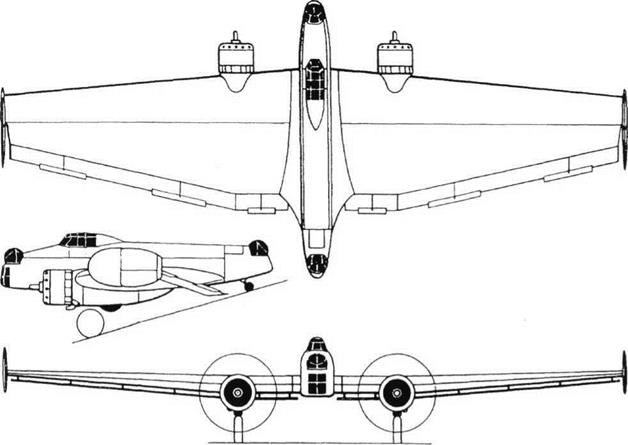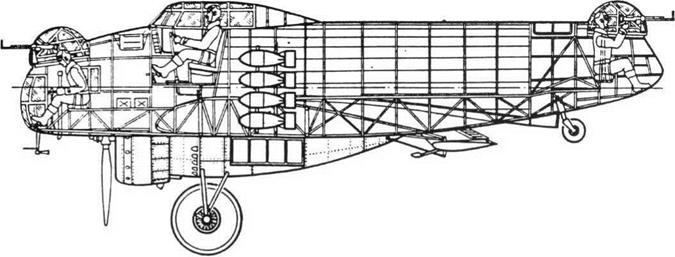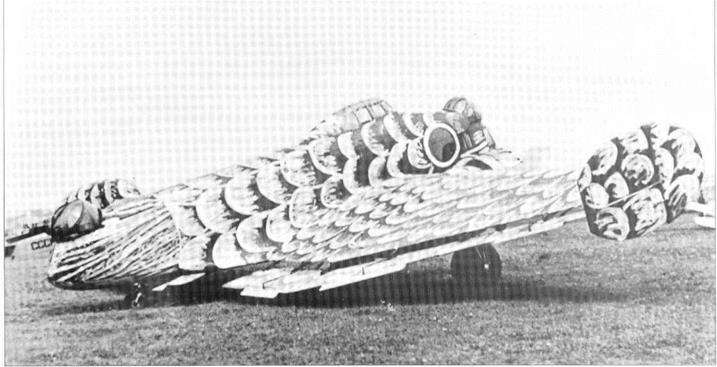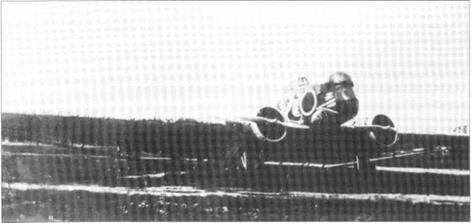Kalinin K-12
 |
Purpose: To create a multirole aircraft with tailless configuration.
Design Bureau: OKB ofK A Kalinin, Voronezh.
In April 1933 Kalinin submitted to the NIl-WS three prelim inary designs for aVS-2 (Voiskovoi Samolyot, troop aircraft) for reconnaissance, bombing, transport, ambulance and other missions. One was conventional, the second had twin tail booms, and the third was tailless. Kalinin preferred the third option, because of supposed lower weight and drag, better manoeuvrability and ease of Fitting a tail turret for defence. He began with the NACA R-106R aerofoil, with slats, park-bench
ailerons, Scheibe wingtip rudders and a vestigial horizontal tail. Tunnel testing of models led to an improved design with a trapezoidal wing ofCAHI (TsAGI) R-II profile, with trailing – edge servo-operated elevators and ailerons of Junkers ‘double wing’ type (as also used by Grokhovskii), the small horizontal tail being eliminated. To test the configuration a halfscale glider (span 10.45m, length 5.2m) was constructed in 1934 and flown over 100 times by V O Borisov. After many problems and arguments, the full-scale aircraft was completed at GAZ (State Aviation Factory) No 18 at Voronezh as the K-12, and flown by Borisov in July 1936. Factory testing was completed in 46 flights. The K-12 was then ferried to
Moscow where its Nil testing was assigned to P M Stefanovskii from October 1936. He found severe control problems, and eventually N N Bazhanov, head of the NIl-WS, refused to accept the K-12 for official trials. From this time onwards Kalinin was under a cloud. The Director of GAZ No 18 joined with Tupolev, Vakhmistrov (see later) and others to impede progress and get the K-12 abandoned. Kalinin moved into Grokhovskii’s summer dacha, the K-12 languishing at Grokhovskii’s KB-29. Contrary to the political tide, Voroshilov ordered the K-12 to fly in the 1937 Air Day parade over Moscow Tushino, and Bazhanov had it painted in a fantastic red/yellow feathered scheme as the Zhar
Ptitsa (firebird or phoenix). It made a great impression, and on 12th December 1937 the Assistant Head of the WS, YaVSmushke – vich, signed an order for renewed NIl-WS testing to start on 1st March 1938, followed by series production of modified aircraft at GAZ No 207. Work began, but in spring 1938 Kalinin’s enemies managed to get him arrested and shot on charges of spying and conspiracy. As he had become an ‘enemy of the people’ the contract was cancelled, the K-12 was scrapped and the ten aircraft on the assembly line were never completed.
The structure of the K-12 was almost entirely based on welded KhMA (Chromansil steel) tubing. The wing comprised left and right panels bolted to the roots, each having one main spar running straight from tip to tip. The fuselage was in three bolted sections, the front section being mainly skinned in Dl, all the rest of the skin being fabric. The trailing – edge and wingtip controls were all fabricskinned Dl. The main landing gears were to have been retractable, but the intended M-25 engines and variable-pitch propellers were not available in time, so weight was saved by making the landing gears fixed. The inadequate engines which had to be fitted were 480hp M-22 (Bristol Jupiter licence), in cowlings with cooling gills, and driving 2.8m
(9ft 2%n) two-blade metal propellers with pitch adjustable on the ground. Crew comprised a pilot in an enclosed cockpit, a navigator who also served as bomb aimer in a nose turret with one 7.62mm ShKAS (he was provided with a rudimentary flight-control lever in case the pilot was incapacitated) and a radio operator in a similar tail turret. Bombload of up to 500kg (l,1021b) was carried on a KD-2 vertical rack behind the main spar and pilot’s cockpit. Other equipment included a V SK-2 radio and AF A-12 camera.
At the end of its life, in early 1938, the K-12 was refitted with 700hp M-25 (Wright Cyclone) engines, driving Hamilton Standard type variable-pitch propellers, but it was never tested in this form. Other modifications included fitting an electrically retractable main landing gear and modified armament. It had also been Kalinin’s intention to replace the wingtip fin/rudder surfaces by rudders above the wings behind the engines, but these were never fitted.
Accounts of this strange tailless aircraft tend either to be strongly positive or strongly negative. There is no doubt Kalinin was the victim of political intrigue, but at the same time the K-12 does not appear to have been a stable or controllable aircraft.
|
Dimensions (As flown with M-22 engines) |
||
|
Span |
20.95m |
68 ft 8M in |
|
Length |
10.32m |
33 ft WA in |
|
Wing area |
72.75m2 |
783 ft! |
|
Weights |
||
|
Empty |
3,070kg |
6,768 Ib |
|
Fuel/oil |
500kg |
1,102 Ib |
|
Loaded |
4,200kg |
9,259 Ib |
|
Performance |
||
|
Maximum speed |
219km/h |
136 mph |
|
Service ceiling |
7,170m |
23,524ft |
|
Range |
700km |
435 miles |
|
Take-off run |
700m |
2,297ft |
|
Landing run |
300m |
984ft |
|



Top: K-12 inboard profile.
 Above and right: Two views of Zhar Ptitsa.
Above and right: Two views of Zhar Ptitsa.










